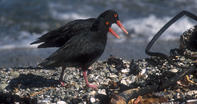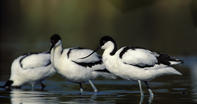An Ecological Wonder
Langebaan Lagoon, which lies just south of St Helena Bay, is one of the ecological wonders of Southern Africa. Every spring more than 50 000 Palaearctic migrant birds travel from the ice-bound extremes of northern Europe and Greenland to feed on the salt marshes and mud flats at the southern curve of the long, narrow inlet.

The curlews with their long, curved beaks probe for crabs and prawns; greater flamingos rake the mud for tiny invertebrate animals; greenshanks, elegant stilts and avocets sweep the water with their odd, upturned bills; turnstones, as their name implies, turn stones over with their beaks to reveal the small mud-dwellers on which they feed; sandpipers patter about rapidly, feeding on worms and crabs, small molluscs and crustaceans; terns wheel in the air on scimitar wings as they hunt for fingerlings in the water beneath; pelicans form nets with their beaks which sweep through the deeper water for fish, at Langebaan Lagoon there is enough for all.
More than two-thirds of all the seasonally migrating waders which visit Langebaan are curlew sandpipers, small birds with mottled grey-brown plumage, a hunched posture and long, down-curved beaks. Individual flocks which may comprise as many as 2 000 birds, settle on exposed mud banks to fatten up before departing for their breeding grounds in far Siberia.
A Natural Filter

Despite its name, Langebaan Lagoon is not a lagoon, neither is it an estuary; it is a very long and narrow inlet that was formed by successive rises and falls in sea level over millions of years, where a gap in the surrounding granite hillocks allowed the fluctuating ocean to erode a narrow passage into the land.
The answer to the seeming mystery as to why the water in this narrow inlet is so clear when the sea outside is a thick soup of plankton and suspended particles are to be found on the seafloor at the mouth of the inlet. Here, filter-feeding white mussels (Donax serra) live in such a tightly packed colony that they filter out most of the particles in the water as the tide flows through the mouth, leaving it as clear as the water around coral reefs, yet with the same salinity level as the sea.
Opposite the mouth of Langebaan, the heavily industrialized port of Saldanha Bay contrasts sharply with the serenity of the inlet. To allow for the loading of iron ore onto large ships, a causeway was built from the mainland to Skaap Island, one of a number of islands that lie at the mouth of Langebaan Lagoon, and which are important breeding colonies for many species of marine birds.
In fact, Malgas, Jutten and Skaap islands are home to breeding colonies of most of the remaining black oyster catchers in the world and a third of all the southern subspecies of swift tern, as well as jackass penguins, Cape and bank cormorants, kelp gulls, Caspian terns and other species.
By David Bristow Langebaan, few towns in South Africa exude as much of a beachy-breakaway feel as this spread-out dorp shimmering along the West Coast shores...
Langebaan, few towns in South Africa exude as much of a beachy-breakaway feel as this spread-out dorp shimmering along the West Coast shores...